Reciprocal regulation of lymphoid tissue development in the large intestine by IL-25 and IL-23
- PMID: 25249168
- PMCID: PMC4424384
- DOI: 10.1038/mi.2014.90
Reciprocal regulation of lymphoid tissue development in the large intestine by IL-25 and IL-23
Abstract
Isolated lymphoid follicles (ILFs) develop after birth in the small and large intestines (SI and LI) and represent a dynamic response of the gut immune system to the microbiota. Despite their similarities, ILF development in the SI and LI differs on a number of levels. We show that unlike ILF in the SI, the microbiota inhibits ILF development in the colon as conventionalization of germ-free mice reduced colonic ILFs. From this, we identified a novel mechanism regulating colonic ILF development through the action of interleukin (IL)-25 on IL-23 and its ability to modulate T regulatory cell (Treg) differentiation. Colonic ILF develop in the absence of a number of factors required for the development of their SI counterparts and can be specifically suppressed by factors other than IL-25. However, IL-23 is the only factor identified that specifically promotes colonic ILFs without affecting SI-ILF development. Both IL-23 and ILFs are associated with inflammatory bowel disease, suggesting that disruption to this pathway may have an important role in the breakdown of microbiota-immune homeostasis.
Figures
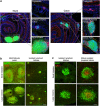

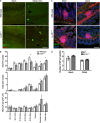


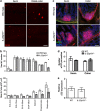

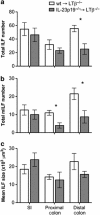
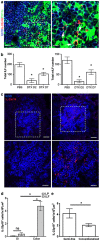
Similar articles
-
Isolated lymphoid follicle maturation induces the development of follicular dendritic cells.Immunology. 2007 Mar;120(3):336-44. doi: 10.1111/j.1365-2567.2006.02508.x. Epub 2006 Dec 5. Immunology. 2007. PMID: 17163957 Free PMC article.
-
Identification of multiple isolated lymphoid follicles on the antimesenteric wall of the mouse small intestine.J Immunol. 2002 Jan 1;168(1):57-64. doi: 10.4049/jimmunol.168.1.57. J Immunol. 2002. PMID: 11751946
-
Isolated lymphoid follicles can function as sites for induction of mucosal immune responses.Ann N Y Acad Sci. 2004 Dec;1029:44-57. doi: 10.1196/annals.1309.006. Ann N Y Acad Sci. 2004. PMID: 15681742
-
IL-21: a new player in the control of isotype switch in Peyer's patches.J Leukoc Biol. 2009 May;85(5):739-43. doi: 10.1189/jlb.0109045. J Leukoc Biol. 2009. PMID: 19406834 Review.
-
Lymphoid microenvironment in the gut for immunoglobulin A and inflammation.Immunol Rev. 2003 Oct;195:190-201. doi: 10.1034/j.1600-065x.2003.00066.x. Immunol Rev. 2003. PMID: 12969319 Review.
Cited by
-
Development and Function of Secondary and Tertiary Lymphoid Organs in the Small Intestine and the Colon.Front Immunol. 2016 Sep 6;7:342. doi: 10.3389/fimmu.2016.00342. eCollection 2016. Front Immunol. 2016. PMID: 27656182 Free PMC article. Review.
-
Label-free Raman spectroscopic imaging to extract morphological and chemical information from a formalin-fixed, paraffin-embedded rat colon tissue section.Int J Exp Pathol. 2016 Aug;97(4):337-350. doi: 10.1111/iep.12194. Epub 2016 Sep 1. Int J Exp Pathol. 2016. PMID: 27581376 Free PMC article.
-
A missense variant in SLC39A8 confers risk for Crohn's disease by disrupting manganese homeostasis and intestinal barrier integrity.Proc Natl Acad Sci U S A. 2020 Nov 17;117(46):28930-28938. doi: 10.1073/pnas.2014742117. Epub 2020 Nov 2. Proc Natl Acad Sci U S A. 2020. PMID: 33139556 Free PMC article.
-
Human gut-associated lymphoid tissues (GALT); diversity, structure, and function.Mucosal Immunol. 2021 Jul;14(4):793-802. doi: 10.1038/s41385-021-00389-4. Epub 2021 Mar 22. Mucosal Immunol. 2021. PMID: 33753873 Review.
-
Epithelial cell-derived cytokine TSLP activates regulatory T cells by enhancing fatty acid uptake.Sci Rep. 2023 Jan 30;13(1):1653. doi: 10.1038/s41598-023-28987-1. Sci Rep. 2023. PMID: 36717741 Free PMC article.
References
-
- Leithauser F., Trobonjaca Z., Moller P., Reimann J. Clustering of colonic lamina propria CD4(+) T cells to subepithelial dendritic cell aggregates precedes the development of colitis in a murine adoptive transfer model. Lab. Invest. 2001;81:1339–1349. - PubMed
Publication types
MeSH terms
Substances
Grants and funding
- BB/G003947/1/BB_/Biotechnology and Biological Sciences Research Council/United Kingdom
- BB/I001107/1/BB_/Biotechnology and Biological Sciences Research Council/United Kingdom
- BBS/E/D/20251967/BB_/Biotechnology and Biological Sciences Research Council/United Kingdom
- BBS/E/D/20251968/BB_/Biotechnology and Biological Sciences Research Council/United Kingdom
LinkOut - more resources
Full Text Sources
Other Literature Sources
Molecular Biology Databases
Miscellaneous

